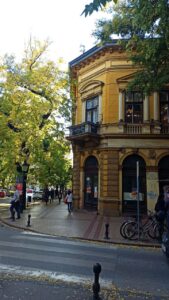Green projects in Subotica’s real estate: how do they affect the market and the environment?
Subotica, a picturesque city in northern Serbia, has been making strides in the realm of sustainable development, particularly in its real estate sector. As environmental concerns gain prominence globally, the integration of green projects into real estate has become a focal point for urban planners, developers, and investors alike. This article explores the impact of green projects on Subotica’s real estate market and the broader implications for the environment.
Green projects in Subotica’s real estate
In recent years, Subotica has witnessed a surge in green real estate projects that prioritize sustainability and energy efficiency. These initiatives often incorporate renewable energy sources, such as solar panels and geothermal heating, which significantly reduce the carbon footprint of residential and commercial properties. Developers are increasingly recognizing the importance of eco-friendly building materials and designs that promote energy conservation, leading to a new standard in construction practices within the city.
Moreover, the local government has been supportive of these green initiatives, offering incentives for developers who adhere to sustainable practices. This includes streamlined permitting processes and potential tax breaks, which encourage investment in environmentally friendly projects. As a result, Subotica is becoming a model for other cities in the region, showcasing how public policy can align with sustainable development goals to foster a greener urban landscape.
The rise of green projects in Subotica’s real estate market is not just a trend; it reflects a broader shift in consumer preferences. Homebuyers and tenants are increasingly seeking properties that offer sustainable features, which has led to a growing demand for eco-friendly homes. This shift is influencing market dynamics, as properties with green certifications tend to command higher prices and attract a more discerning clientele.
How do they affect the market?
The introduction of green projects in Subotica’s real estate market has led to a notable transformation in property values. Homes and commercial spaces that incorporate sustainable features are often perceived as more desirable, leading to increased demand and, consequently, higher market prices. This trend is particularly evident in neighborhoods that prioritize green spaces and energy-efficient buildings, which are becoming hotspots for buyers looking to invest in sustainable living.
Additionally, the presence of green projects can enhance the overall appeal of a neighborhood, attracting new residents and businesses. As more developers embrace sustainable practices, the competition in the market intensifies, prompting existing property owners to consider renovations and upgrades to maintain their competitiveness. This ripple effect not only boosts property values but also contributes to the revitalization of urban areas, making them more attractive for investment.
However, the shift towards green real estate is not without challenges. Developers face higher upfront costs associated with sustainable building practices, which can deter some from pursuing green projects. Moreover, the market is still in a transitional phase, and there is a need for greater public awareness about the long-term benefits of investing in eco-friendly properties. As education and advocacy efforts increase, it is likely that the market will continue to evolve, further integrating sustainability into its core.
How do they affect the environment?
The environmental impact of green projects in Subotica is profound, as these initiatives contribute significantly to reducing the city’s overall carbon emissions. By utilizing renewable energy sources and implementing energy-efficient technologies, green buildings help to decrease reliance on fossil fuels, leading to cleaner air and a healthier urban environment. This shift not only benefits residents but also aligns with global efforts to combat climate change.
Furthermore, green projects often incorporate sustainable landscaping and water management practices, which enhance biodiversity and improve local ecosystems. By creating green spaces, such as parks and community gardens, these developments promote ecological balance and provide residents with recreational areas that foster community engagement. This holistic approach to urban planning is essential for creating resilient cities that can adapt to the challenges posed by climate change.
In addition to these environmental benefits, green projects in Subotica also serve as a catalyst for community awareness and involvement in sustainability efforts. As residents witness the positive impacts of eco-friendly developments, they are more likely to adopt sustainable practices in their own lives, fostering a culture of environmental stewardship. This collective effort can lead to significant long-term benefits for both the city and its inhabitants, creating a more sustainable future for Subotica.
In conclusion, the emergence of green projects in Subotica’s real estate market represents a significant shift towards sustainability that benefits both the economy and the environment. As developers and consumers increasingly prioritize eco-friendly practices, the city is poised to become a leader in sustainable urban development. By continuing to support and invest in green initiatives, Subotica can pave the way for a healthier, more resilient future, setting an example for other cities to follow.


